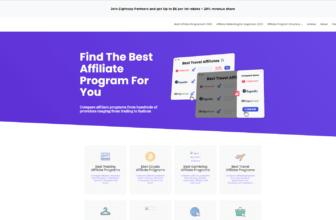
Tips to Choose the Best Affiliate Programs in 2025
As online marketing and e-commerce continue to evolve, affiliate marketing remains one of the most accessible and effective ways to generate revenue through online partnerships. By 2025, affiliate programs are more abundant and more sophisticated than ever, offering diverse paths to earn commissions through product recommendations, content promotion, and brand partnerships. But with countless options available, how do you choose the best affiliate programs for your unique goals and audience? This comprehensive guide is designed to help you navigate the affiliate marketing landscape, identify opportunities that align with your niche, and set yourself up for long-term success.
Table of Contents
- Understanding Affiliate Programs
- The Growing Relevance of Affiliate Marketing in 2025
- Key Criteria for Selecting the Best Affiliate Programs
- Relevance to Your Niche
- Product Quality and Brand Reputation
- Competitive Commission Structure
- Cookie Duration and Attribution Models
- Tools, Resources, and Support
- Payment Terms and Reliability
- Marketing Restrictions and Compliance
- Scalability and Growth Potential
- Popular Types of Affiliate Programs
- Commission-Based Affiliate Programs
- Recurring (Rebill) Commission Programs
- Co-Branded Affiliate Programs
- Advertising Network Programs
- Partner Programs
- Leading Affiliate Networks and Platforms to Consider
- Google Ads and AdSense
- Amazon Associates
- Specialized Networks for Your Niche
- Emerging Platforms and the Creator Economy
- Practical Tips for Evaluating and Joining Affiliate Programs
- Conducting Thorough Product Research
- Reviewing Conversion Rates and EPC (Earnings Per Click)
- Checking Program Policies and Guidelines
- Assessing Support and Communication Channels
- Monitoring Trends and Forecasts
- Enhancing Visibility Through SEO and Marketing Techniques
- Importance of SEO in Affiliate Marketing
- Why You Should Consider Professional Guidance (e.g., SEO Consultant CT)
- Leveraging Social Media, Email Marketing, and Content Syndication
- Strategies to Optimize and Scale Your Affiliate Earnings
- A/B Testing Affiliate Offers
- Diversifying Your Affiliate Portfolio
- Building Trust and Authority Within Your Audience
- Tracking and Analyzing Performance Metrics
- Conclusion: Evolving with the Market
1. Understanding Affiliate Programs
At its core, an affiliate program is a revenue-sharing partnership between a merchant (the company selling products or services) and an affiliate (you, the marketer, publisher, or influencer). The affiliate’s role is to promote the merchant’s offerings through various channels—such as blog posts, social media, videos, or email newsletters—and earn a commission whenever a referral leads to a sale, sign-up, or another specified conversion.
When you join an affiliate program, you receive unique tracking links or codes that attribute any resulting conversions to your promotional efforts. This allows you to earn money without having to develop your own products, handle inventory, or manage customer support. It’s a mutually beneficial arrangement: the merchant gains exposure to new audiences, and you receive compensation for facilitating that exposure and driving revenue.
2. The Growing Relevance of Affiliate Marketing in 2025
The affiliate marketing landscape has changed dramatically over the past few years. With improved tracking technologies, sophisticated analytics, and a proliferation of e-commerce platforms, affiliate marketing has become more accessible and data-driven. Here are a few reasons why affiliate marketing remains highly relevant in 2025:
- Increased Internet Accessibility: More people worldwide have reliable internet access, which expands the potential customer base for online merchants and affiliates.
- Niche Specialization: Audiences now prefer highly specialized content from trusted experts. This opens the door for affiliates who can establish credibility in a specific niche, from health and wellness to cutting-edge technology.
- Rising Creator Economy: Content creators, podcasters, YouTubers, influencers, and bloggers can integrate affiliate links seamlessly into their content, offering valuable recommendations and earning commissions.
- Robust Tracking & Analytics: Improved tools ensure affiliates get credit for their referrals and help them optimize their campaigns effectively.
As the digital ecosystem continues to flourish, choosing the right affiliate programs to partner with will be a key component of building a sustainable online income.
3. Key Criteria for Selecting the Best Affiliate Programs
In 2025, it’s not enough to simply choose any affiliate program and hope for success. You need a systematic approach to evaluate opportunities. The following criteria will guide you in selecting the best programs that align with your brand and objectives.
Relevance to Your Niche
Your affiliate program should align closely with your content focus and audience interests. For instance, if you run a travel blog, partnering with an affiliate program that offers travel gear, luggage, hotel bookings, or flight deals makes logical sense. Promoting irrelevant products not only reduces conversion rates but can also undermine your credibility.
Product Quality and Brand Reputation
Your reputation is on the line whenever you recommend something. Always assess the merchant’s brand reputation, customer reviews, and product quality before joining their affiliate program. Low-quality products or questionable brands can lead to negative audience feedback and long-term damage to your credibility.
Competitive Commission Structure
While commission rates vary widely depending on the product category and network, be sure to understand how you’ll be compensated. High-ticket items (like software subscriptions or luxury products) often yield higher commissions, while physical products may pay lower rates but convert more easily. Look for a fair and transparent structure—some programs even offer tiered commissions, granting better rates as your performance improves.
Cookie Duration and Attribution Models
Cookie duration determines how long after a user clicks your affiliate link you’ll receive credit for a sale. Short cookie windows (24 hours) can be limiting, especially for products with a longer buying cycle. In 2025, look for programs with longer cookie durations or more sophisticated attribution models. Some merchants track multi-touch attribution, ensuring you receive credit if you played a significant role in the buyer’s journey.
Tools, Resources, and Support
The best affiliate programs provide helpful resources—such as detailed product descriptions, professionally designed banners, email templates, and sometimes even promotional videos. Strong support teams can assist with technical issues, tracking discrepancies, and timely payouts. The more support and resources you have at your disposal, the smoother your campaigns will run.
Payment Terms and Reliability
Reliable and timely payments are essential. Check how and when the affiliate program pays out. Some pay monthly via direct deposit, PayPal, or wire transfers. Others might require a minimum earnings threshold. Ensure the payment options and schedule fit your financial needs.
Marketing Restrictions and Compliance
In an age of increased online regulation, make sure you understand all marketing restrictions upfront. Some affiliate programs prohibit specific promotional methods like paid search on brand keywords, certain social media advertising tactics, or incentivized traffic. Ensure you can promote the product within the guidelines provided and remain compliant with government regulations (like the FTC guidelines in the U.S. or GDPR in the EU).
Scalability and Growth Potential
As you plan for 2025 and beyond, think about long-term growth. Will the affiliate program remain relevant as your brand expands? Can you scale your efforts by promoting more products or negotiating better commissions? Consider the longevity and flexibility of the partnership.
4. Popular Types of Affiliate Programs
Affiliate programs come in various forms. Understanding these common structures will help you identify the one that best suits your business model and goals.
Commission-Based Affiliate Programs
How They Work: You earn a set percentage or fixed amount per sale. Once a user clicks your link and completes a purchase, you receive a commission. This is the most common and straightforward type of affiliate program.
Example: An online retailer selling electronics might offer a 5% commission on every sale referred through your links.
Pros: Simplicity, predictable earnings per sale.
Cons: Income is limited by individual conversions.
Recurring (Rebill) Commission Programs
How They Work: With a recurring model, you continue to earn commissions as long as the customer you referred remains subscribed or continues making purchases. This often applies to SaaS (Software as a Service) products, subscription boxes, or membership-based services.
Example: A web hosting company paying a monthly commission as long as the customer you referred keeps their hosting account active.
Pros: Potentially stable, passive income streams.
Cons: Must choose quality services to ensure long-term customer retention.
Co-Branded Affiliate Programs
How They Work: You partner with a merchant to create co-branded promotions. You benefit from the merchant’s brand recognition, and they gain credibility through your endorsement. This often results in a more integrated and trust-inspiring promotion.
Example: A fitness influencer co-branding with a health supplement company to launch a special edition product line.
Pros: Enhances trust and can improve conversion rates.
Cons: Requires alignment in branding and target audience.
Advertising Network Programs
How They Work: Advertising networks like Google AdSense or media networks offer revenue sharing based on clicks, impressions, or conversions of ads displayed on your website.
Example: Displaying banner ads from Google AdSense and earning a portion of advertising revenue whenever visitors click those ads.
Pros: Easy to implement, passive income.
Cons: Can be less profitable than commission-based sales if your traffic or targeting is not optimized.
Partner Programs
How They Work: Often used by influencers and content creators, partner programs allow you to promote products without necessarily being labeled as an “affiliate.” It’s a more integrated model where you might recommend products naturally as part of your content.
Example: A YouTuber integrates product recommendations in their video content, earning commissions through unique tracking links.
Pros: Non-intrusive and can feel more authentic.
Cons: Might offer fewer traditional affiliate tools or structured tiers.
5. Leading Affiliate Networks and Platforms to Consider
In 2025, a wide range of affiliate networks and platforms helps you find the right merchants and manage your campaigns seamlessly.
Google Ads and AdSense
While not strictly an affiliate program, Google Ads and AdSense allow publishers to monetize their content through display advertising. If you already have significant web traffic, placing targeted ads can generate steady revenue. Although not commission-based for product sales, these platforms are worth considering to diversify your income streams.
Amazon Associates
The Amazon Associates program remains a top choice due to Amazon’s massive inventory and global presence. With millions of products available, you can easily find items relevant to any niche. Amazon’s trust factor and streamlined checkout process often result in strong conversion rates, though commission rates have fluctuated over the years.
Key Features:
- Wide product selection across virtually every category.
- Straightforward tracking and analytics.
- Multiple payment methods and an established, reliable platform.
Specialized Networks for Your Niche
If your niche is very specific, consider joining a specialized affiliate network or direct brand affiliate programs that cater to that space. For example:
- ShareASale: Popular for boutique and niche merchants.
- CJ Affiliate (Commission Junction): Large range of established brands.
- Impact: Offers a variety of premium merchants and sophisticated tracking tools.
- ClickBank: Known for digital products and courses with often higher commissions.
These networks can help you compare different offers and manage all your affiliate relationships in one place.
Emerging Platforms and the Creator Economy
As the creator economy continues to flourish, new platforms designed for influencers and content creators have emerged. These platforms streamline the affiliate process, offer brand deals, and facilitate co-branded campaigns. For instance:
- LTK (LikeToKnow.It): Specializing in fashion and lifestyle affiliates.
- Influencer Marketing Platforms (e.g., AspireIQ, Grin): Connecting brands directly with content creators for partnership opportunities.
6. Practical Tips for Evaluating and Joining Affiliate Programs
Before diving in, it’s wise to undertake a thorough evaluation process to ensure a program meets your needs.
Conducting Thorough Product Research
Do not recommend products blindly. Test them if possible or gather third-party reviews. Investigate the merchant’s return and refund policies. If you trust the product and believe in its value, it will reflect in your promotions and increase conversion rates.
Reviewing Conversion Rates and EPC (Earnings Per Click)
Look for metrics like EPC (Earnings Per Click) and overall conversion rates. Affiliate networks often provide this data. High EPC suggests that the program’s products convert well, meaning you stand a better chance of earning a substantial income from your promotional efforts.
Checking Program Policies and Guidelines
Before signing up, carefully read the affiliate agreement and policies. Ensure you understand payment thresholds, attribution models, marketing restrictions, and policies against unethical practices like cookie stuffing or spamming. Compliance is crucial to maintaining a long-term, sustainable affiliate business.
Assessing Support and Communication Channels
A responsive affiliate manager or support team can be invaluable. They can help optimize your campaigns, provide marketing materials, troubleshoot tracking issues, and even share insights into upcoming product launches or promotions.
Monitoring Trends and Forecasts
The digital landscape evolves fast. Keep tabs on industry trends, new product launches, and seasonal promotions. By anticipating market shifts, you can join programs that have strong growth potential and adapt your promotional strategies accordingly.
7. Enhancing Visibility Through SEO and Marketing Techniques
Even the best affiliate programs won’t yield results if your audience never sees your content. Organic traffic generated through search engine optimization (SEO) remains a powerful driver of conversions.
Importance of SEO in Affiliate Marketing
Ranking high on search engines for relevant keywords positions your affiliate recommendations in front of potential buyers at the exact moment they’re seeking solutions. By producing high-quality, keyword-rich content—such as buying guides, product reviews, and how-to articles—you can attract organic traffic and increase your conversion potential.
Why You Should Consider Professional Guidance (e.g., SEO Consultant CT)
If SEO feels overwhelming, consider seeking professional help. An SEO consultant—such as an SEO consultant CT—can help you identify target keywords, optimize your website structure, improve site speed, and ensure you’re following best practices. Professional SEO support can boost your visibility and position you as a go-to resource in your niche, ultimately increasing affiliate earnings.
Leveraging Social Media, Email Marketing, and Content Syndication
Diversify your promotional channels. Use social media platforms like Instagram, TikTok, YouTube, or LinkedIn to reach different audience segments. Build an email list and regularly share valuable tips, insights, and relevant product recommendations. Consider content syndication and guest posting on reputable websites to broaden your reach.
8. Strategies to Optimize and Scale Your Affiliate Earnings
Choosing the best affiliate programs is only the first step. To maximize your earning potential, you’ll need to refine your promotional strategies, test new approaches, and continuously improve your marketing tactics.
A/B Testing Affiliate Offers
Not all offers will convert equally. Experiment with different banner placements, call-to-action buttons, email subject lines, and even product selections. Use analytics tools to track click-through rates, conversions, and earnings. Over time, you’ll discover what resonates best with your audience.
Diversifying Your Affiliate Portfolio
Relying solely on one merchant or product category can be risky. Spread your partnerships across multiple programs within your niche. This not only reduces dependence on a single income source but also accommodates a broader range of audience interests.
Building Trust and Authority Within Your Audience
To succeed in affiliate marketing, prioritize trust. Offer honest reviews, mention both pros and cons of products, and be transparent about your affiliate relationships. As your audience sees your integrity and understands that you only promote quality products, they’ll be more likely to purchase based on your recommendations.
Tracking and Analyzing Performance Metrics
Use analytics tools (like Google Analytics and the affiliate network’s dashboard) to track performance. Pay attention to:
- Conversion Rates: The percentage of visitors who complete the desired action.
- Earnings Per Click (EPC): How much you earn on average per click.
- Return on Ad Spend (ROAS): If you use paid traffic.
- Customer Lifetime Value (LTV): For recurring commission programs.
Analyzing these metrics provides actionable insights that help refine your promotions and scale what works.
9. Conclusion: Evolving with the Market
As 2025 progresses, affiliate marketing continues to mature, offering unprecedented opportunities for online entrepreneurs. By choosing the right affiliate programs that align with your niche, provide quality products, and offer supportive resources, you lay the foundation for success. Remember to consider commission structures, cookie durations, and compliance policies before joining any program.
Don’t forget the importance of SEO and other marketing techniques. Gaining visibility and building trust with your audience are keys to consistent conversions. If necessary, seek professional help (like an SEO consultant) to ensure you’re following best practices.
In the long run, it’s not just about selecting the best affiliate program—it’s about continuously refining your strategy, adapting to emerging trends, and providing ongoing value to your audience. By staying informed, experimenting with new methods, and maintaining ethical, transparent practices, you’ll cultivate a sustainable, growth-oriented affiliate marketing business in 2025 and beyond.








